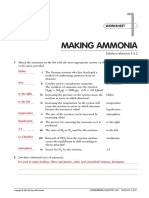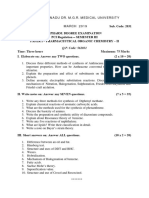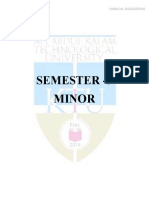0 ratings0% found this document useful (0 votes)
148 viewsAoc 2
Aoc 2
Uploaded by
irfanThis document contains three past examination papers for a Master of Pharmacy degree in Pharmaceutical Chemistry. Each paper tests students on advanced organic chemistry concepts through essay and short answer questions. The papers assess students' understanding of reaction mechanisms, synthesis strategies, structure-activity relationships, stereochemistry, heterocyclic compounds, and other key organic chemistry topics relevant to drug development.
Copyright:
Attribution Non-Commercial (BY-NC)
Available Formats
Download as PDF, TXT or read online from Scribd
Aoc 2
Aoc 2
Uploaded by
irfan0 ratings0% found this document useful (0 votes)
148 views3 pagesThis document contains three past examination papers for a Master of Pharmacy degree in Pharmaceutical Chemistry. Each paper tests students on advanced organic chemistry concepts through essay and short answer questions. The papers assess students' understanding of reaction mechanisms, synthesis strategies, structure-activity relationships, stereochemistry, heterocyclic compounds, and other key organic chemistry topics relevant to drug development.
Original Title
aoc2
Copyright
© Attribution Non-Commercial (BY-NC)
Available Formats
PDF, TXT or read online from Scribd
Share this document
Did you find this document useful?
Is this content inappropriate?
This document contains three past examination papers for a Master of Pharmacy degree in Pharmaceutical Chemistry. Each paper tests students on advanced organic chemistry concepts through essay and short answer questions. The papers assess students' understanding of reaction mechanisms, synthesis strategies, structure-activity relationships, stereochemistry, heterocyclic compounds, and other key organic chemistry topics relevant to drug development.
Copyright:
Attribution Non-Commercial (BY-NC)
Available Formats
Download as PDF, TXT or read online from Scribd
Download as pdf or txt
0 ratings0% found this document useful (0 votes)
148 views3 pagesAoc 2
Aoc 2
Uploaded by
irfanThis document contains three past examination papers for a Master of Pharmacy degree in Pharmaceutical Chemistry. Each paper tests students on advanced organic chemistry concepts through essay and short answer questions. The papers assess students' understanding of reaction mechanisms, synthesis strategies, structure-activity relationships, stereochemistry, heterocyclic compounds, and other key organic chemistry topics relevant to drug development.
Copyright:
Attribution Non-Commercial (BY-NC)
Available Formats
Download as PDF, TXT or read online from Scribd
Download as pdf or txt
You are on page 1of 3
March 2009
[KU 319] Sub. Code: 2855
M.PHARM. DEGREE EXAMINATION
(Regulations 2006)
Candidates admitted from 2006-2007 onwards
FIRST YEAR
Branch II – PHARMACEUTICAL CHEMISTRY
Paper II – ADVANCED ORGANIC CHEMISTRY
Q.P. Code : 262855
Time : Three hours Maximum : 100 marks
Answer All questions
I. Essay Questions : (3 x 20 = 60)
1. a) Explain the mechanism and reactivity of addition reaction to carbon
–hetero multiple bonds.
b) Write a note on delocallized chemical bonding.
c) Draw the Tablonski diagram and discuss the energy transition.
2. a) Discuss the mechanism and reactivity of aliphatic nucleophilic
substitution reaction with example.
b) Give the application of Mannich reaction with suitable example.
c) Give the stability and structure of carbon ions.
3. a) What are the various types of pericyclic reactions, Discuss their
mechanisms.
b) Explain the asymmetric synthesis for preparing chiral drugs with an
example.
c) Discuss the synthones approach for carbon-carbon bond formation.
II. Write Short Notes : (8 x 5 = 40)
1. Discuss the Resonance and field effects of structure on reactivity.
2. Give the application of combinatorial chemistry.
3. Comment on the various reagents used for oxidation- reduction
reactions.
4. Discuss the Michael reaction with an example.
5. Outline the synthesis of pyrrole and furan.
6. Discuss the synthetic utility of Grignard reaction.
7. Explain the phase transfer catalysis in anhydride..
8. What are the various approaches for deprotection of groups.
******
September 2009
[KV 319] Sub. Code: 2855
M.PHARM. DEGREE EXAMINATION
(Regulations 2006)
Candidates admitted from 2006-2007 onwards
FIRST YEAR
Branch II – PHARMACEUTICAL CHEMISTRY
Paper II – ADVANCED ORGANIC CHEMISTRY
Q.P. Code : 262855
Time : Three hours Maximum : 100 marks
Answer All questions
I. Essay Questions : (3 x 20 = 60)
1. a) Define heterocyclic compound. Classify them with examples.
Explain the preparation, properties and uses of any six membered
heterocycle compounds.
b) Explain the importance of combinational chemistry in drug
discovery.
2. a) Explain different techniques for preparing chiral drugs.
b) Explain how stereo chemistry effects the biological action of a drug.
3. a) Explain in detail about retrosynthetic analysis.
b) Briefly give a detailed explanation about phase transfer catalysis.
II. Write Short Notes : (8 x 5 = 40)
1. Discuss about stability of carbocations.
2. Explain the importance of Mannich bases.
3. Explain why pyridine is less basic than aliphatic amines.
4. Explain with examples various pericylic reactions.
5. Explain the synthesis and uses of grignard reagents.
6. Write the mechanism involved in:
a) Micheal reaction b) Hoffman rearrangement.
7. Compare and explain the reactivity of furan and pyrrole.
8. Explain the addition to carbon-carbon multiple bonds.
******
March 2010
[KW 319] Sub. Code: 2855
M.PHARM. DEGREE EXAMINATION
(Regulations 2006)
Candidates admitted from 2006-2007 onwards
FIRST YEAR
Branch II – PHARMACEUTICAL CHEMISTRY
Paper II – ADVANCED ORGANIC CHEMISTRY
Q.P. Code : 262855
Time : Three hours Maximum : 100 marks
Answer All questions
I. Essay Questions : (3 x 20 = 60)
1. a) Define free radical. Explain in detail the formation of free radial.
Explain any reaction involving free radical.
b) Explain in detail the effect of structure on reactivity.
2. a) Explain with examples how chirality influences the biological
activity of a drug .
b) Explain the techniques used to prepare chiral drugs.
3. a) Explain in detail with mechanism about Beckman rearrangement.
b) Discuss about aromatic electrophilic substitution.
II. Write Short Notes : (8 x 5 = 40)
1. Give an account of macro beads in new solid phase synthesis.
2. Write the mechanism involved in wolf – kishner reduction.
3. Explain hyperconjugation.
4. Explain the importance of N-Bromosuccinamide in organic synthesis.
5. Distinguish between SN1 and SN2 reaction.
6. Pinacole – pinacolone rearrangement.
7. Define hemolytic and heterolytic bond fission.
8. Explain about fries rearrangement.
******
You might also like
- Lab - Nerve ReflexesDocument6 pagesLab - Nerve Reflexesirfan100% (1)
- Crux and Reagents of Organic ChemDocument4 pagesCrux and Reagents of Organic ChemBILL RUSSO100% (6)
- Making Ammonia: WorksheetDocument4 pagesMaking Ammonia: WorksheetckNo ratings yet
- Previous 10 Year Question Paper PocDocument21 pagesPrevious 10 Year Question Paper Pocjoel gNo ratings yet
- POC-1, University Question PaperDocument8 pagesPOC-1, University Question Papersatheeshpharma6100% (1)
- 562039LPDocument10 pages562039LPaboobacker8526No ratings yet
- Q.P. Code: 564252Document3 pagesQ.P. Code: 564252vinay0717No ratings yet
- 562031LODocument8 pages562031LOS A N K A RNo ratings yet
- 564251KYDocument20 pages564251KYSudharsanaveediappan EthirajanNo ratings yet
- 05 Chemistry UG MODEL PAPERS ANU 2020-21Document8 pages05 Chemistry UG MODEL PAPERS ANU 2020-21Maria Rayappan S.No ratings yet
- Rajiv Gandhi University of Health Sciences, Karnataka: Q.P. CODE: 2604Document1 pageRajiv Gandhi University of Health Sciences, Karnataka: Q.P. CODE: 2604VISHNU RAJ VNo ratings yet
- Rajiv Gandhi University of Health Sciences, Karnataka: Q.P. CODE: 1954Document1 pageRajiv Gandhi University of Health Sciences, Karnataka: Q.P. CODE: 1954Mahesh ARNo ratings yet
- Chem LocDocument2 pagesChem LocprabhakarvancedNo ratings yet
- Pharmaceutical AnalysisDocument19 pagesPharmaceutical AnalysisDeepak VermaNo ratings yet
- Poc I QP2Document1 pagePoc I QP2VISHNU RAJ VNo ratings yet
- 2015 Apr-Biochemistry & Physical ChemistryDocument2 pages2015 Apr-Biochemistry & Physical ChemistryD PrajnaNo ratings yet
- Q.P. Code: 383805Document20 pagesQ.P. Code: 383805Kiran saiNo ratings yet
- Organic SynthesisDocument5 pagesOrganic SynthesisGuruKPONo ratings yet
- NR 2100802 Organic ChemistryDocument4 pagesNR 2100802 Organic ChemistrySRINIVASA RAO GANTANo ratings yet
- MC I Univ QPDocument7 pagesMC I Univ QPsivaranjaniv28No ratings yet
- Poc I Sessional Paper IDocument2 pagesPoc I Sessional Paper Irathodhari07No ratings yet
- S4 Main Internal QUESTION PAPER 18 02-2020 EditedDocument2 pagesS4 Main Internal QUESTION PAPER 18 02-2020 EditedACT KeralaNo ratings yet
- InstDocument3 pagesInstAbhipsa SinhaNo ratings yet
- Semester-IV Chemistry Paper-V Syllabus and Model PaperDocument5 pagesSemester-IV Chemistry Paper-V Syllabus and Model PaperVamsi ArisettiNo ratings yet
- Wa0033.Document4 pagesWa0033.SANKARA RAO NEIGAPULANo ratings yet
- 1.pgpha - 5118 - Advanced Organic Chemistry-I - TTP (November-2017) - November-2017 (Oct-17)Document1 page1.pgpha - 5118 - Advanced Organic Chemistry-I - TTP (November-2017) - November-2017 (Oct-17)agilaNo ratings yet
- CAPE Chemistry Syllabus Unit 2 Page 1 of 12: Structure and Formulae (Module 1)Document12 pagesCAPE Chemistry Syllabus Unit 2 Page 1 of 12: Structure and Formulae (Module 1)Fabian SealeyNo ratings yet
- As Chem - Revision ChecklistDocument5 pagesAs Chem - Revision ChecklistmtoNo ratings yet
- Q.P. Code: 262951Document13 pagesQ.P. Code: 262951Siva Ram SNo ratings yet
- B.Sc. (Chemistry) Part-I 2017-18, 2018-19 & 2019-20Document11 pagesB.Sc. (Chemistry) Part-I 2017-18, 2018-19 & 2019-20Ritish KumarNo ratings yet
- Question Paper B Pharmacy 2nd Sem BP104TDocument2 pagesQuestion Paper B Pharmacy 2nd Sem BP104TNeeru MalikNo ratings yet
- 28 June BP401T-Organic Chemistry IV Sem New SyllabusDocument2 pages28 June BP401T-Organic Chemistry IV Sem New SyllabusRaja RajaNo ratings yet
- 383803KVDocument27 pages383803KVHarish .MNo ratings yet
- 2-Environmental Chemistry and MicrobiologyDocument8 pages2-Environmental Chemistry and MicrobiologyAjay VermaNo ratings yet
- CBSE Sample Paper Class 12 Chemistry Set 2 PDFDocument5 pagesCBSE Sample Paper Class 12 Chemistry Set 2 PDFManoj kumarNo ratings yet
- Chem 122 AssignmentDocument6 pagesChem 122 AssignmentBen Noah EuroNo ratings yet
- Chemistry Paper VI SyllabusDocument7 pagesChemistry Paper VI SyllabusPrudhvi Raghu TejaNo ratings yet
- Pre - Ph.D. Examination Pharmacy: (April-19) (RPH-141)Document1 pagePre - Ph.D. Examination Pharmacy: (April-19) (RPH-141)pradeep36No ratings yet
- New-CBCS - III-Sem - Full Imp-Qs ListDocument2 pagesNew-CBCS - III-Sem - Full Imp-Qs Listpolumatlajoy9515No ratings yet
- Third Semester M.Sc. Pharmaceutical Chemistry: Ph3C09 Synthetic and Bioorganic ChemistryDocument9 pagesThird Semester M.Sc. Pharmaceutical Chemistry: Ph3C09 Synthetic and Bioorganic ChemistrySreedevi KrishnakumarNo ratings yet
- M Pharm PDFDocument49 pagesM Pharm PDFkothi hemaraniNo ratings yet
- Chemistry PDFDocument5 pagesChemistry PDFJahanzaib khanNo ratings yet
- Engg. Chemistry AHT-002 Model Question BankDocument2 pagesEngg. Chemistry AHT-002 Model Question Bankraushanpathak464No ratings yet
- Gujarat Technological UniversityDocument1 pageGujarat Technological UniversityJaineshNo ratings yet
- Q.P. Code: 262941Document1 pageQ.P. Code: 262941S Regurathi PandianNo ratings yet
- r0532804 Biochemical EnggDocument4 pagesr0532804 Biochemical EnggSRINIVASA RAO GANTANo ratings yet
- Pharm - 2604 - Pharm. Org. Chemistry - I - Pottp (December-2018) - December-2018 (Apr-19)Document1 pagePharm - 2604 - Pharm. Org. Chemistry - I - Pottp (December-2018) - December-2018 (Apr-19)preranan25No ratings yet
- Pharm D POC QuestionsDocument16 pagesPharm D POC Questionspradeep36No ratings yet
- Junior Chemistry Smart AcademyDocument8 pagesJunior Chemistry Smart Academyaheadkhan593No ratings yet
- Chemical EngineeringDocument9 pagesChemical EngineeringanushafiNo ratings yet
- Organic ChemistryDocument1 pageOrganic ChemistryGuruKPONo ratings yet
- Organic Chemistry IIDocument1 pageOrganic Chemistry IIGuruKPONo ratings yet
- Pharmaceutical Chemistry IIIDocument1 pagePharmaceutical Chemistry IIIUma NathNo ratings yet
- B.pharm 2015 Pharmaceutical Organic ChemistryDocument1 pageB.pharm 2015 Pharmaceutical Organic ChemistryZafeer Ul IslamNo ratings yet
- Chemistry Syllabus (2016)Document52 pagesChemistry Syllabus (2016)Vipin singh100% (1)
- BCHCT-133 (Eng) 2020Document4 pagesBCHCT-133 (Eng) 2020vdefbv daefNo ratings yet
- Chemistry SyllabusDocument23 pagesChemistry SyllabusMukhil R PillaiNo ratings yet
- Bpharm 3rd Sem Question PapersDocument10 pagesBpharm 3rd Sem Question PapersltzmusikindiaNo ratings yet
- Modern Methods of Pharmaceutical AnalysisDocument12 pagesModern Methods of Pharmaceutical AnalysisJafrineNo ratings yet
- PUC Chemistry-1Document2 pagesPUC Chemistry-1Manoj K CNo ratings yet
- 07a1bs08 Physical ChemistryDocument4 pages07a1bs08 Physical ChemistrySRINIVASA RAO GANTANo ratings yet
- Progress in Physical Organic ChemistryFrom EverandProgress in Physical Organic ChemistryRobert W. TaftNo ratings yet
- Multicomponent Reactions: Concepts and Applications for Design and SynthesisFrom EverandMulticomponent Reactions: Concepts and Applications for Design and SynthesisNo ratings yet
- Dr. A. Puratchikody: Problems and Prospectus of Pharmaceutical Industries in IndiaDocument14 pagesDr. A. Puratchikody: Problems and Prospectus of Pharmaceutical Industries in IndiairfanNo ratings yet
- 2-2laboratory Techniques Slide Preparation and StainsDocument30 pages2-2laboratory Techniques Slide Preparation and StainsirfanNo ratings yet
- The Basic Teaching of BuddhaDocument17 pagesThe Basic Teaching of BuddhairfanNo ratings yet
- A General Method For The Quaternization of N, N-Dimethyl Benzylamines With Long Chain N-AlkylbromidesDocument4 pagesA General Method For The Quaternization of N, N-Dimethyl Benzylamines With Long Chain N-AlkylbromidesirfanNo ratings yet
- Fisher Scientific - New Price Book 2013-14Document57 pagesFisher Scientific - New Price Book 2013-14irfanNo ratings yet
- 1 IntroductionDocument22 pages1 IntroductionirfanNo ratings yet
- QSAR, Pharmacophore and Docking Studies On Human Phaspholipase A2 InhibitorsDocument104 pagesQSAR, Pharmacophore and Docking Studies On Human Phaspholipase A2 Inhibitorsirfan100% (1)
- Pearson Chemistry TeachingDocument51 pagesPearson Chemistry TeachingZheng Joey100% (1)
- S Matthew's Reaction Rates ExperimentDocument3 pagesS Matthew's Reaction Rates Experimentapi-27085921No ratings yet
- Activity Sheet 7Document3 pagesActivity Sheet 7airishNo ratings yet
- MSC ChemistryDocument54 pagesMSC ChemistryShivam Vinoth100% (1)
- Thermochem ThermodynamicsDocument25 pagesThermochem ThermodynamicsVincent FloraNo ratings yet
- Saponification A Comparative KineticDocument112 pagesSaponification A Comparative KineticAnonymous kVO13HLdCmNo ratings yet
- Zheng Et Al 2023 Chatgpt Chemistry Assistant For Text Mining and The Prediction of Mof SynthesisDocument15 pagesZheng Et Al 2023 Chatgpt Chemistry Assistant For Text Mining and The Prediction of Mof SynthesisRajib ChowdhuryNo ratings yet
- IGCSE Chemistry 0620 Opportunities For Practical ActivitiesDocument52 pagesIGCSE Chemistry 0620 Opportunities For Practical ActivitiesGhaleb W. Mihyar100% (14)
- General Properties of Transition Metals 1 QPDocument10 pagesGeneral Properties of Transition Metals 1 QPaanammanaNo ratings yet
- A2 CHM 10 Arenes NotesDocument26 pagesA2 CHM 10 Arenes NotesArishaNo ratings yet
- PUC I Year ... CHEMISTRY Chapterwise Imp QuestionsDocument50 pagesPUC I Year ... CHEMISTRY Chapterwise Imp Questionschaithrayalawar328No ratings yet
- Mathematical Modelling of Catalytic Exhaust Systems For Euro 3 and Euro 4 Emissions StandardsDocument11 pagesMathematical Modelling of Catalytic Exhaust Systems For Euro 3 and Euro 4 Emissions StandardsTwinkleNo ratings yet
- Biology Ch. 2 Review Questions KEY 1Document4 pagesBiology Ch. 2 Review Questions KEY 1ColeenNo ratings yet
- r05310805 Chemical Reaction Engineering IDocument8 pagesr05310805 Chemical Reaction Engineering ISrinivasa Rao GNo ratings yet
- Chapter 6Document17 pagesChapter 6helloblarg100% (3)
- Nitric Acid Synthesis Nitric Acid SynthesisDocument9 pagesNitric Acid Synthesis Nitric Acid SynthesisMarianne Eka ViariNo ratings yet
- Writing Balanced Chemical EquationsDocument3 pagesWriting Balanced Chemical EquationsDamian YeoNo ratings yet
- H2 ChemistryDocument19 pagesH2 Chemistry恺楷开No ratings yet
- Module 3 Carbon CompoundsDocument16 pagesModule 3 Carbon Compoundshulk3706100% (3)
- AGU Fall Meeting 2010 Scientific ProgramDocument560 pagesAGU Fall Meeting 2010 Scientific ProgramDr Ghulam JafferNo ratings yet
- Sulphur - Kirk OthmerDocument37 pagesSulphur - Kirk OthmerForsakenHopeNo ratings yet
- Fall 2022 Chem215-1 Syllabus KnezzDocument14 pagesFall 2022 Chem215-1 Syllabus Knezzapi-309287593No ratings yet
- Numerical Simulation of Hydrogen Combustion: Global Reaction Model and ValidationDocument7 pagesNumerical Simulation of Hydrogen Combustion: Global Reaction Model and ValidationEduardoNo ratings yet
- Acido Nitrico A17 293 PDFDocument50 pagesAcido Nitrico A17 293 PDFjaspreetNo ratings yet
- AP Daily Live Review - Week 1 (Fill in PDFDocument20 pagesAP Daily Live Review - Week 1 (Fill in PDFm mmNo ratings yet
- GCSE - A Level Chemistry Transition Gcse Questions.199272016Document13 pagesGCSE - A Level Chemistry Transition Gcse Questions.199272016miyu kanzakiNo ratings yet
- Hydrogenation: Heterogeneous CatalysisDocument10 pagesHydrogenation: Heterogeneous CatalysisAnand SwarnkarNo ratings yet
- PHREEQC Manual CivilEng AdvectionDocument151 pagesPHREEQC Manual CivilEng AdvectionLeynard NatividadNo ratings yet

































































































